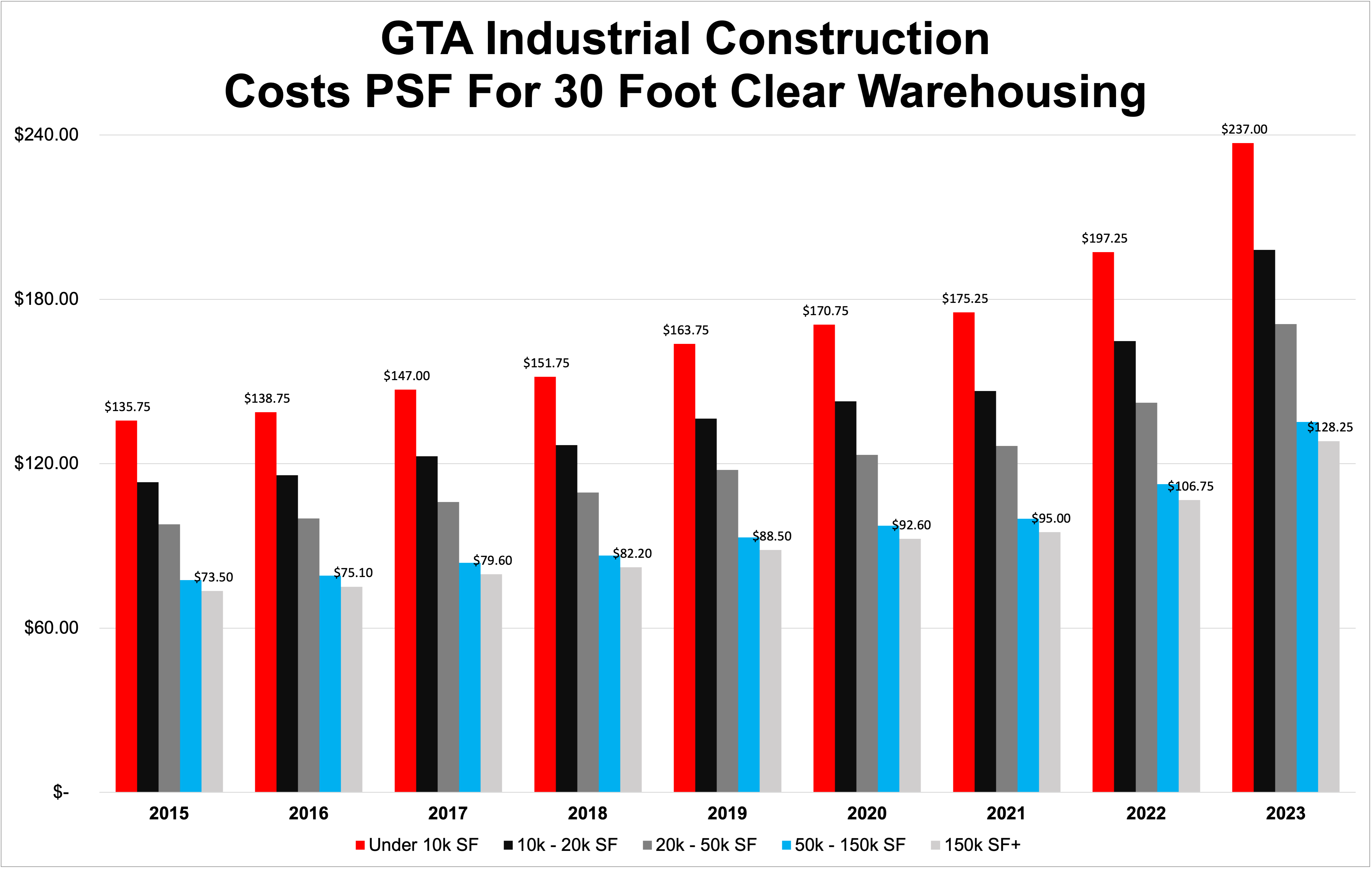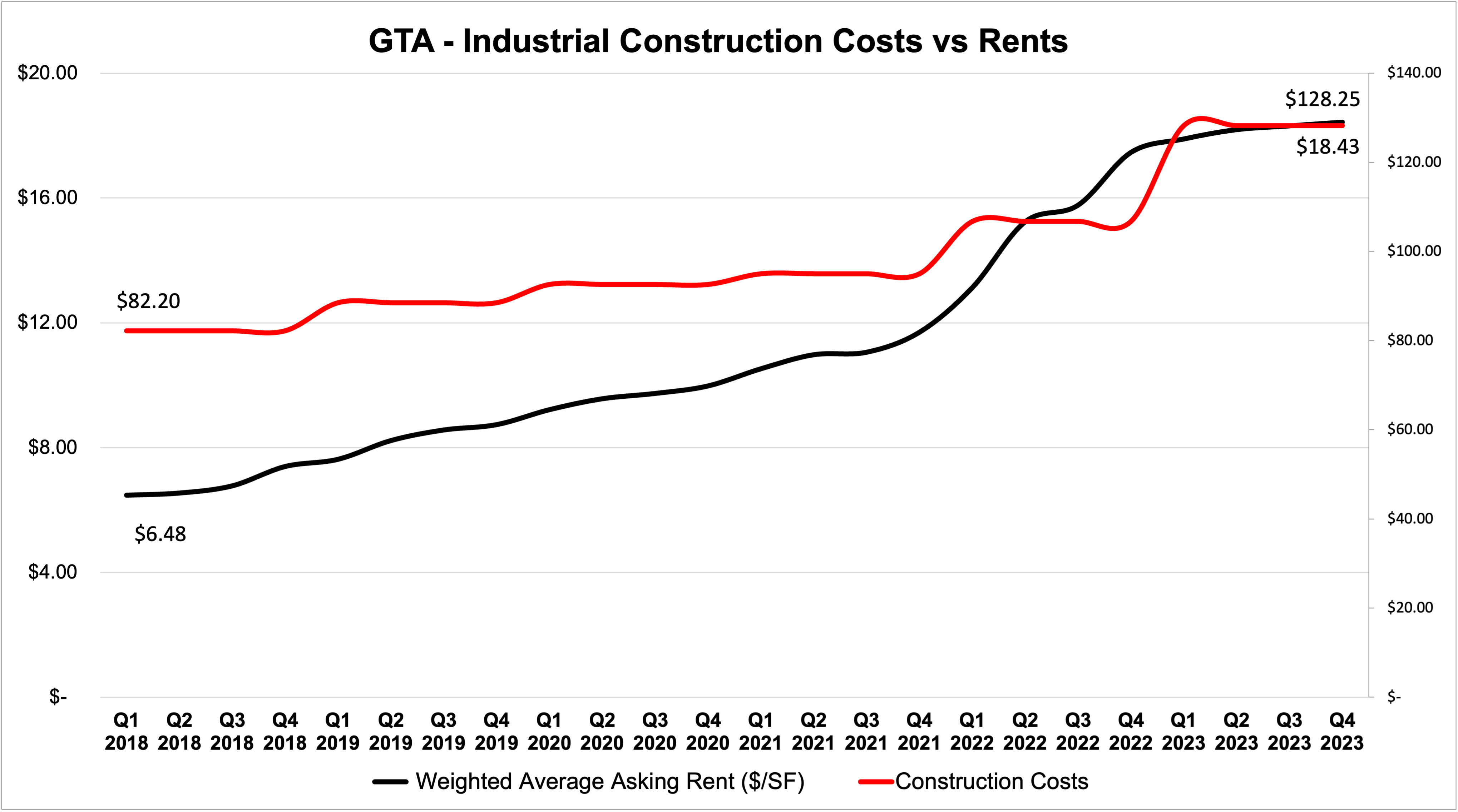Time seems to have compressed ever since we came out of the pandemic.
Maybe it was simply a catalyst for change. Or perhaps we were all making up for lost time.
Or within the context of industrial real estate, the emergence of e-commerce and the resulting demand for warehousing and logistics facilities emphasized the need and signalled the profitability surrounding Bix Box space.
Whatever the reason may be, broad economic forces, regional drivers, and industrial real estate dynamics have been in constant flux. The rise of interest rates from all-time lows. The scale of the industrial pipeline and resulting flood of deliveries. The dramatic increase in costs to develop new facilities. The softening in demand from occupiers and investors.
All of these narratives and phenomena have led to an industrial real estate market that continues to be sought-after, but where decisions and negotiations have become more prevalent and more strategic.
In 2023, we saw the market cool; with rents and values stabilizing, as well as availabilities pushing up to 1.9% (the last time they were above that mark was in Q2 2018). Some tenants pulled back on expansion plans, while some downsized their footprints (see Amazon, for example). Developers became relatively more conscious of competing properties and less enthusiastic about building on-spec, while landlords also changed their mentalities from wanting to push the market’s limits on rents to being satisfied with quality tenants paying market rates.
So what will 2024 bring?
As inflation cools and interest rates are expected to plateau, perhaps we will finally see some predictability in terms of costs and values, although they will likely not come down to pre-expansion levels.
Elevated labour, land, development, and material costs mean that quality real estate will inherently maintain its value as it cannot be replaced easily, quickly, or cheaply.
Similarly, operating costs have increased noticeably in taxes, maintenance, and utilities. We are seeing a trend towards net-zero carbon (as discussed in past issues) and energy efficiencies to help offset this and meet upcoming mandates. Overall, high-cost environments lend themselves to better property management and fully-tenanted buildings.
More available options should see tenants focus more on building specifications and location, meaning high-quality facilities will continue to command a premium on older inventory. As a result, there are many opportunities to add value through infill redevelopment. Bifurcation between modern, Class-A space and functionally obsolete space will also continue.
Aside from these ‘crystal ball’ thoughts, we can be sure that there will be a curveball or two that will be impossible to predict. All one can do is try to study the market, be prepared for opportunity when it comes knocking, and do their best to roll with the punches.
That is why, for this week’s newsletter, we will analyze the GTA industrial market’s historical industrial construction cost data to gain a better understanding of how the market has evolved, and to help get a sense of what is to come.
GTA Historical Industrial Construction Cost Analysis
As you can see below, the cost to build industrial properties in the Greater Toronto Area has increased dramatically since 2015.
Obviously, costs can vary greatly on a project by project basis, depending on hard and soft costs such as land values, development charges, labour, and materials, as well as specifications such as power, cooler/freezer, clear height, office buildout, etc… That said, the methodology for our data has tried to create an ‘apples to apples’ comparison by looking at what it would take to build a traditional warehouse with basic shell buildout. That means, if you’re a tenant with specific requirements, expect to pay more.

GTA Industrial Construction Costs PSF on 30’ Clear Industrial, 2018 to 2023. Source: TRREB.
Looking at the numbers, whereby a ‘Big Box’ warehouse of over 150,000 SF would’ve run you $73.50 per square foot in 2015, a developer would have faced a new build at approximately $128.25 PSF in 2023; a 74.5% increase in just 8 years.
Smaller size ranges are understandably more expensive on a per square foot basis due to certain fixed costs, and have all increased within the same time period at a similar, if not greater, pace.

GTA Industrial Under Construction, Deliveries, and Construction Costs, 2018 to 2023. Source: C&W, TRREB.
The standing narrative around this shift is largely attributed to the pandemic and the resulting increase in cost of land, labour, and materials. Land became a hot commodity as e-commerce drove demand for new industrial inventory – which was itself quickly becoming scarce in general – but logistics users also sought out modern specs of 40-foot-plus clear heights and enormous footprints that have gone well over a million square feet.
The data supports this too.
Year over year, increases in construction costs from 2015 through 2023 were:
2018/19 (7.66%), 2019/20 (4.63%), 2020/21 (2.59%),
2021/22 (12.37%), 2022/23 (20.14%)

GTA Industrial Under Construction Costs vs Industrial Rents, 2018 to 2023. Source: C&W, TRREB.
Important Takeaways:
- The cost to construct industrial properties over 150,000 SF has increased from $73.50 PSF in 2015 to $128.25 PSF in 2023.
- Similarly, putting up a warehouse under 10,000 SF has grown from $135.75 PSF in 2015 to $237 PSF in 2023.
- Construction costs for Big Box jumped by 12.37% year-over-year in 2022 and 20.14% Y-o-Y in 2023; posing the question if this is a delayed and contained market reaction or a new ‘normal’ trend.
- As our second chart shows, costs correlate with the inventory under construction, as well as new deliveries, however, causation is not a single-variable equation. And in a complex system, causation can go both ways and create a feedback loop. This occurred, notably, throughout and after the economic lockdowns.
- Further, we see an explosion of pipeline in mid-2021, followed by a spike in costs in early 2022. However, costs continue to climb at their highest pace after the total square feet under development began to slow. We can attribute this to the aforementioned stickiness of wages – and even input costs – which take longer to adjust and tend not to want to go down.
- Bottom line: constructing industrial has simply become more expensive.
- That said, as a Landlord, rents have also increased from $6.48 PSF net in 2018 to $18.43 PSF net in 2023, which has been necessary to make these projects feasible.
- Finally, as an Industrial Occupier, the focus should not only be on the absolute value of your rents, but what you get per dollar. Larger cubic volumes, the ability to integrate warehouse management systems such as racking and robotics, heavy power, and LEED/Net Zero Carbon designations all allow for greater efficiencies and throughputs, as well as, in theory, lower operating costs.
- Overall, to answer our initial question: construction costs alone have not been a large deterrent to new supply. They, of course, are a concern, and can impact certain projects, as well as impact rents and values. That said, if Users need space, it will be built. What we are seeing, due to these costs, coupled with vacancies, is more caution around speculative builds, as well as certain developments being put on pause or delayed to either first find a Tenant or allow for other inventory to lease up.
Conclusion:
Looking ahead, the industrial market continues to defy the broader economic uncertainty and remains highly sought-after; both to purchase and lease – it just will depend on the individual asset.
While some may say that sentiment has changed, or speak of both investors and occupiers putting plans on the shelf, vacating space, or downsizing, let’s not forget that this is typical in any normal market. What we had experienced over the past three to seven years was a landscape with constrained supply and a red-hot logistics and warehousing industry. As vacancies push up towards the 3% mark (and as interest rates plateau or eventually and gradually fall) tenants will have more options, buyers will regain confidence, and pricing will further stabilize.
As is with common sense, it may certainly be more challenging or rigorous to complete a deal, obtain financing, go through development, or even secure a tenant. That said, if you currently own a well-maintained and -located industrial property within the GTA, there are still large institutional and private investors with dry powder seeking to obtain these assets, both for their strong cashflows and as a hedge against inflation and any potential threats to the financial system.
If selling your property is still something you would consider but have not followed through with for any reason, it is not too late to do so… just ensure that you go into any sales process with a clear strategy and expectations, as well as an understanding of potential outcomes.
For a confidential consultation or a complimentary opinion of value of your property please give us a call.
Until next week…
Goran Brelih and his team have been servicing Investors and Occupiers of Industrial properties in Toronto Central and Toronto North markets for the past 30 years.
Goran Brelih is an Executive Vice President for Cushman & Wakefield ULC in the Greater Toronto Area.
Over the past 30 years, he has been involved in the lease or sale of approximately 25.7 million square feet of industrial space, valued in excess of $1.6 billion dollars while averaging between 40 and 50 transactions per year and achieving the highest level of sales, from the President’s Round Table to Top Ten in GTA and the National Top Ten.
Specialties:
Industrial Real Estate Sales and Leasing, Investment Sales, Design-Build and Land Development
About Cushman & Wakefield ULC.
Cushman & Wakefield (NYSE: CWK) is a leading global real estate services firm that delivers exceptional value for real estate occupiers and owners. Cushman & Wakefield is among the largest real estate services firms with approximately 53,000 employees in 400 offices and 60 countries.
In 2020, the firm had revenue of $7.8 billion across core services of property, facilities and project management, leasing, capital markets, valuation and other services. To learn more, visit www.cushmanwakefield.com.
For more information on GTA Industrial Real Estate Market or to discuss how they can assist you with your real estate needs please contact Goran at 416-756-5456, email at goran.brelih@cushwake.com, or visit www.goranbrelih.com.
Connect with Me Here! – Goran Brelih’s Linkedin Profile: https://ca.linkedin.com/in/goranbrelih
Goran Brelih, SIOR
Executive Vice President, Broker
Cushman & Wakefield ULC, Brokerage.
www.cushmanwakefield.com
Office: 416-756-5456
Mobile: 416-458-4264
Mail: goran.brelih@cushwake.com
Website: www.goranbrelih.com


